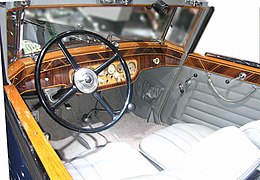Listen 12
| listen | |
|---|---|
|
Horch 670 twelve-cylinder convertible (1932)
|
|
| 12 | |
| Sales designation: | 670, 600 |
| Production period: | 1931-1934 |
| Class : | Upper class |
| Body versions : | Pullman limousine , convertible , landaulet |
| Engines: |
Otto engines : 6.05 liters (88 kW) |
| Length: | 5400-5550 mm |
| Width: | 1820 mm |
| Height: | 1650-1720 mm |
| Wheelbase : | 3450-3750 mm |
| Empty weight : | 2950-3200 kg |
The Horch 12 (type 670 and 600) are cars with twelve-cylinder engine from the Zwickau Horch works (from June 1932 part of the Auto Union ). The Horch 670/600 were the first German vehicle to have engines with hydraulic valve lifters , which meant that valve clearance did not have to be adjusted .
Of the 81 cars built between 1931 and 1934, four Horch 670 cabriolets have survived.
General
In autumn 1931 - before the merger of Audi , DKW , Horch and Wanderer to form Auto Union - the 670 was first presented at the Paris Motor Show with a 3.45 meter wheelbase , which was only available as a two-door convertible . By the end of production in 1934, the Zwickau plant had built a total of 53 Horch 670s .
In 1932 Auto Union presented the Horch 600 , which was used with a 3.75 m wheelbase for the sedan and the four-door Pullman convertible. After delivery of 28 vehicles, Horch 600 production ended in 1933.
Both vehicles largely corresponded in appearance to the eight-cylinder Horch type 780B and 500B. The three-part windshield was striking. The Horch 12 competed with the eight-cylinder Mercedes type 770 ("Big Mercedes") and the twelve-cylinder Maybach Zeppelin DS 8 . Since many potential customers had less money after the global economic crisis of 1929, the Horch vehicles with a new price from 23,500 Reichsmarks were significantly cheaper than the Mercedes or Maybach cars (approx. 45,000 or 35,000 RM, based on the year 1932 these sums adjusted for purchasing power in today's currency approx. 106,000, 202,000 and 157,000 euros)
engine and gears
The newly designed by Fritz Fiedler 120 HP (88 kW) at 3200 rpm strong V-engine with 6 liters displacement and 66 degrees bank angle has a sevenfold bearing crankshaft . The camshaft, which is driven by a chain with an automatic tensioning device, is located centrally between the two cylinder banks and actuates the horizontally arranged valves ( SV valve control ) via rocker arms . The sealing surface between the cylinder block and head, and thus the head gasket, were kinked. The driver was able to supply lubricating oil to the cylinders and pistons from the dashboard via a dedicated line system, which increased the compression and thus made a cold start easier.
The four-speed manual transmission from Zahnradfabrik Friedrichshafen is operated with a gear lever in the middle of the car. The transitions between two and four are synchronized so that when switching no declutching required or "double clutching".
chassis
The conventional chassis with leaf-sprung rigid axles at the front and rear came from the eight-cylinder 780B / 500B. The Bosch Dewandre servo brake with suction air support reduced the pedal force. As a special feature, the Horch had 12 built-in hydraulic jacks for changing wheels.
Museum distribution
Horch 670 Cabriolet are in museum mobile of Audi in Ingolstadt, the cottage of the Autostadt in Wolfsburg and in the Cité de l'Automobile - Collection Schlumpf to visit in Mulhouse in Alsace (France).
Technical specifications
| Type | 670 | 600 |
|---|---|---|
| Construction period | 1931-1934 | 1932-1933 |
| Superstructures | Cb2 | PL4, PC4 |
| engine | Twelve-cylinder V-engine, 4-stroke | |
| Valves | standing (sv) | |
| Bore × stroke | 80 mm × 100 mm | |
| Displacement | 6031 cc | |
| power | 120 hp (88 kW) at 3200 rpm | |
| consumption | approx. 26 l / 100 km | approx. 28 l / 100 km |
| Top speed | 140 km / h | 130 km / h |
| Empty weight | 2300 kg | 2500 kg |
| Perm. total weight | 2950 kg | 3200 kg |
| Electrics | 12 volts | |
| frame | U-profile pressed steel frame, screwed to the body |
|
| Suspension | Rigid axles with semi-elliptical springs and hydraulic shock absorbers |
|
| Brakes | hydraulically operated drum brakes on all four wheels, mechanically operated parking brake, acting on the rear wheels |
|
| length | 5400 mm | 5550 mm |
| width | 1820 mm | |
| height | 1650 mm | 1720 mm |
| wheelbase | 3450 mm | 3750 mm |
| Front / rear track | 1470 mm / 1500 mm | |
| Turning circle | 14.5 m | 16.5 m |
- PL4 = 4-door Pullman - Limousine
- PC4 = 4-door Pullman convertible
- Cb2 = 2-door convertible
literature
- Peter Kirchberg, Jürgen Pönisch: Horch. Types - technology - models. Delius Klasing, Bielefeld 2006, ISBN 978-3-7688-1775-2 .
- Werner Oswald : All Horch automobiles 1900–1945. 1st edition, Motorbuch Verlag , Stuttgart 1979, ISBN 3-87943-622-3 .
- Werner Oswald: German Cars 1920–1945. All German passenger cars of the time. 10th edition, Motorbuch Verlag, Stuttgart 1996, ISBN 3-87943-519-7 .
Web links
- Horch 670 - Auto Union's most luxurious production car at www.autostadt.de (pdf; 0.5 MB)
Individual evidence
- ↑ The figures were based on the template: Inflation determined, rounded to 1000 EUR and apply to the previous January.
- ↑ The quiet giant - autozeitung.de of 1 December 2006
- ↑ Kirchberg, Pönisch: Horch , Delius Klasing 2006, p. 178
- ↑ Wiecking K. Gebauer R., The engines of passenger cars, Stuttgart 1951



